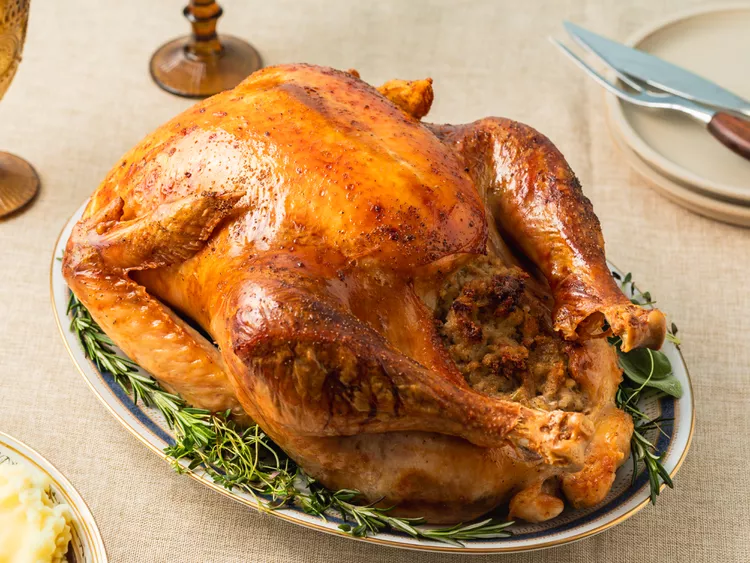The Dry Brine Protocol: A Masterclass for the Ultimate Thanksgiving Turkey
The traditional Thanksgiving turkey serves as the defining culinary centerpiece of the holiday, yet the quest for a bird that is both profoundly juicy and impeccably crisp often remains elusive. Culinary science and professional methodologies have converged on a simple, yet highly effective technique: the dry brine.1 This formal guide outlines the definitive, SEO-optimized protocol for achieving a flawlessly seasoned and roasted turkey.
I. Strategic Preparation: Thawing and Osmotic Curing
The groundwork for a perfect roast must begin days in advance, focusing on precise temperature control and the foundational dry brine.
H2 Turkey Selection and Safe Thawing Guidelines
Accurate sizing and meticulous thawing are critical preconditions for food safety and even cooking.
-
Sizing Convention: Plan for a minimum allocation of 1.5 pounds (approx.2 0.7 kg) of turkey per guest to accommodate standard portions and desired leftovers.
-
Thawing Protocol: Frozen turkeys must be thawed slowly within a controlled refrigeration unit, maintaining a temperature no higher than 3$40^\circ\text{F}$ (4$4^\circ\text{C}$).5 Allow approximately 24 hours of thawing time for every 4-5 pounds of turkey weight.6
| Turkey Weight (Lbs) | Minimum Refrigerator Thaw Duration |
| 12-16 | 3–4 days |
| 16-20 | 4–5 days |
| 20-24 | 5–6 days |
H3 The Dry Brine: Maximizing Flavor and Skin Crispness
The dry brine utilizes salt to draw out moisture, which then creates a concentrated saline solution that is reabsorbed into the meat.7 This process seasons the turkey throughout and concurrently dehydrates the skin’s surface, ensuring superior texture upon roasting.8
-
Preparation: Remove giblets and neck.9 Pat the turkey completely dry with paper towels.10
-
Brine Application: Calculate the required amount of Kosher salt (approximately 1 tablespoon per 4-5 pounds of turkey).11 Gently rub the salt over the entire exterior, the cavity, and crucially, directly onto the breast meat by separating the skin.12
-
Curing Phase: Place the turkey, uncovered, on a wire rack set over a baking sheet and refrigerate for 24 to 48 hours.13 This air-drying period is essential for the final crispness of the golden-brown skin.14
II. Roasting Protocol: Temperature Modulation and Flavor Enhancement
On the day of the feast, specific preparation and roasting steps are necessary to balance the cooking rates of the white and dark meat.
H2 The Compound Herb Butter Rub
Approximately one hour before roasting, remove the turkey from refrigeration to initiate a controlled temperature increase, promoting even cooking.15
-
Formula: Prepare a compound butter using softened unsalted butter, minced garlic, lemon zest, and finely chopped classical poultry herbs (rosemary, thyme, sage).
-
Application: Insert a majority of the butter under the skin covering the breast meat, and apply the remainder uniformly across the exterior.16 This serves as the primary fat source for flavor and browning, negating the need for frequent, heat-disrupting basting.
H3 Cavity Aromatics and Roasting Setup
For optimal safety and superior flavor, all stuffing must be cooked outside the turkey.17 The cavity should be loosely filled with aromatics (e.g., quartered onions, lemon halves, herb sprigs) to infuse the meat and enrich the pan drippings for turkey gravy.18
Place the turkey on a roasting rack or a bed of coarsely chopped root vegetables within a roasting pan to elevate the bird, ensuring air circulation for uniform heat distribution.19
H2 Controlled Roasting Technique
-
Initial Sear: Begin roasting at a high temperature, typically 20$425^\circ\text{F}$ (21$220^\circ\text{C}$), for 30–45 minutes to rapidly crisp the skin.22
-
Sustained Cook: Reduce the oven temperature to 23$325^\circ\text{F}$ (24$160^\circ\text{C}$) for the remainder of the cook time.25
-
Thermal Shielding: If the breast skin begins to darken excessively, loosely tent the area with aluminum foil to slow its absorption of radiant heat.26
III. The Criterion of Doneness and Mandatory Rest
The success of the process is non-subjective, resting entirely on internal temperature readings and a mandatory resting phase.
H2 Thermometric Validation for a Juicy Turkey
An instant-read thermometer is the indispensable instrument for verifying doneness and preventing the cardinal error of overcooking.27
-
Safe Minimum Temperature (USDA Standard): 28$165^\circ\text{F}$ (29$74^\circ\text{C}$) in three locations: the thickest part of the breast, the innermost part of the thigh, and the wing joint.30
-
Professional Target for Juiciness: Many chefs remove the turkey when the thigh reaches $165^\circ\text{F}$ and the breast registers $155^\circ\text{F}$ to $160^\circ\text{F}$ ($68^\circ\text{C}$ to $71^\circ\text{C}$), relying on carryover cooking during the rest to safely reach the $165^\circ\text{F}$ mark.
H2 The Redistribution of Juices: Resting
Upon removal from the oven, the turkey must be transferred to a cutting board and rested for a minimum of 30 minutes, loosely tented with foil. This period is scientifically critical: it permits the muscle fibers to relax, halting the expulsion of moisture and allowing the internal juices to redistribute throughout the meat, guaranteeing tenderness upon carving.
Adherence to this dry brine protocol and precise thermal monitoring transforms the preparation of the Thanksgiving turkey into a dependable, professional-grade culinary endeavor, resulting in a perfectly juicy and flavorful holiday main course.31
